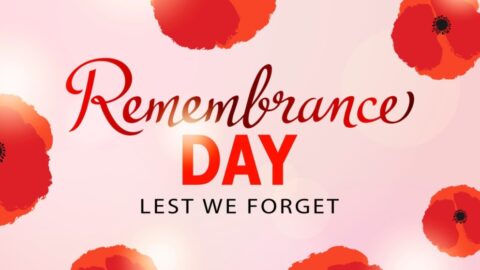“Their name liveth for evermore.”

This Saturday, at the eleventh hour, of the eleventh day, of the eleventh month, we will once again observe Remembrance Day, and reflect on the lives and events of time past.
‘Pledge of Remembrance’
The Australian soldier grows not old, the flame still lights his eyes
Although his body lays to rest, his flag forever flies
On the green and gold horizon where the wattles sweep and sway
It flies amongst the gardens and the classrooms of today
Over ocean streams and backyard dreams, above the sunburnt plain
Through harvest yields, on sporting fields, in rainbows after rain
It defines a life worth living and a day that must be won
For every father’s daughter and for every mother’s son
But more than that, the honour claimed in fighting for the free
The pride of the Australian soldier burns in you and me
When the night is dark and dangerous with the rumble of the storm
His courage calls the sunrise, and his spirit makes it warm
We will not forget their sacrifice – the strength of their endeavour
For the choices we are gifted with, that flame will burn forever
With a smile that lights the future shining brightly in our scope
We will stand as one, together – we will carry on with hope
But as we go, we take the words that rightfully belong
“I am young, and I am worthy, I am brave and I am strong
In the face of any challenge, I will strive to rise above
I deserve this opportunity to live, to learn, to love
I can truly make a difference; my path is up to me
And this is my commitment – be the best that I can be.”
As we observe Remembrance Day this week, I suggest that the important thing is not the day or the date, but the act of remembering. In remembering, we think of the unknown courage and self-sacrifice so many gave, with that distinctive fellowship of mateship that we as Australians prize so highly.
It is impossible for us to imagine the hardships endured in the mud of Flanders, the burning sands of North Africa, the steaming jungles of Burma, on the Kokoda Track, the degradation of the prisoner of war camps, or the sandstorms of Iraq and Afghanistan.
In almost every country town across Australia, there is a war memorial. Most of them were erected after the First World War to honour the soldiers who served, mostly those who never made it back home. On these memorials is a list of names. However, they are not just names. In small regional towns those names listed were known by most. It was also not uncommon to have the same surname appear a number of times as families lost more than one member.
In our recent Remembrance Day Assembly, I reflected on my own hometown in Ballarat. Many will have driven through the Arch of Victory and the row of trees, known as the Avenue of Honour. The Ballarat Avenue, at 22 kilometres, is the longest Avenue of Honour in Australia, a total of 3,801 trees extend over the distance. A tree was planted for each soldier, sailor, and nurse from the district who served during the First World War. It is one of the earliest known memorials to have been planted in Victoria. It represents an egalitarian approach to the commemoration of service personnel where service rank was not a consideration.
If you have ever lived in an Australian country town or driven through on your way to somewhere you will often have passed a war memorial, perhaps Stawell, Horsham, or Adelaide, and through the Avenue of Honour. Most include a figure of a soldier in World War One uniform, his rifle inverted, his eyes cast down, and, on the column at his feet, name after name of those who have fought and often died in wars. Completing the list of names, the long familiar words: “their name liveth for evermore’ (Ecclesiasticus 44: 14).
We have all rushed past memorials like this with barely a glance, let alone a thought to what they represent. I am guilty of this in my own childhood. The Avenue and Arch are less than a kilometre from my old school on the foreshore of Lake Wendouree.
This Saturday, we will pause to remember, not just to honour those names from the distant or even recent past, but to contemplate their stories, to better understand our own. We will honour their memory by achieving what they sought to achieve, by being what they hoped to be. They will continue to live in our memory and in our actions. “At the going down of the sun and in the morning, we will remember them.”
So, on Remembrance Day, we make present those past lives that have intertwined with our lives. We engage their faces that look out at us from old photographs. We name their names. We recall their deeds. “Their name liveth for evermore.”


